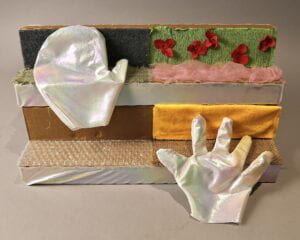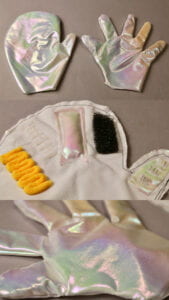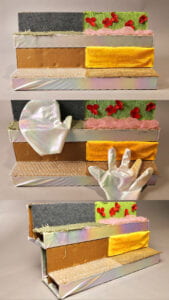Title: Magic Gloves

Project Description / Introduction:
My project is a glove designed to alter the sense of touch by preventing the wearer from feeling the actual textures of the materials they touch. Inspired by silicone dishwashing gloves, I wanted to create a playful experience and by wearing the glove, the user’s fingers are isolated and unable to perceive the true textures, thus distorting their tactile perception. This project intends to explore the “malleability” of our sensory perception and challenge our reliance on touch to understand our environment.
Perspective and Context:
My project aligns with the concepts of art and perception, particularly with the interplay between the mind and the senses. As stated by Irwin in his writings, “Our minds direct our senses every bit as much as our senses inform our minds. Our reality in time is confined to our ideas about reality. ” (Irwin 24) This idea suggests that our perception of the world is not only determined by the external stimuli we encounter but also by the interpretations that happen in our minds. Thus, by altering the tactile experience, the gloves disrupt the direct correspondence between touch and the perception of texture. The wearer’s mind is persuaded to fill in the gaps, relying on preconceived notions to make sense of the objects they touch.
Lastly, the project invites individuals to question the limitations of their own perceptions and the role of sensory experiences in shaping their understanding of reality because it prompts a deeper exploration of how our perceptions are constructed and how they influence our relationship with the world. Through this artistic intervention, I intend to provoke reflection and dialogue about the intricate relationship between the mind, the senses, and the construction of our subjective realities.
Development & Technical Implementation:
The process of making my project involved a combination of research, experimentation, and remaking multiple gloves. I began by exploring ways to manipulate the sense of touch with various prototypes and it involved asking my friends to try it to gather feedback and improve the glove.

I also tried different approaches such as sewing different sizes of gloves and adding more layers or textures inside the glove. As a result, the wearer is unable to accurately perceive the true textures of the objects. To interact with the project, a person simply puts on the glove and explores the different textures or surfaces. They can touch and feel the textures or engage in sensory movements such as shaking hands.
Presentation:
During the presentation, I began by giving a short introduction to my project, explaining how the gloves work. I allowed my classmates to try the gloves themselves, which led to initial confusion as they realised they couldn’t feel the textures of the materials. It was at this point that I clarified that the inability to feel the textures was the intended concept behind the project.
As more people tested the gloves, I realised that despite creating two different sizes, they were still too small for some individuals. This realisation highlighted the importance of considering a diverse range of users should be able to interact with my future projects.

Conclusion:
During this project, I have learned valuable lessons about the interplay between art, perception, and design. I discovered the complexity of altering tactile perception and the challenges of creating a glove that effectively distorts the sense of touch. While the concept of the project was well-received, I realised that the sizing of the gloves was not suitable for all individuals, pointing out the importance of considering inclusivity in the future.
I succeeded in creating an interactive experience for my peers and witnessing their curiosity and fascination was a rewarding outcome of the project. Hence, I would like to improve the functionality and accessibility of the gloves as well as be interested in exploring different materials and textures to further enhance the disconnection between touch and perception.